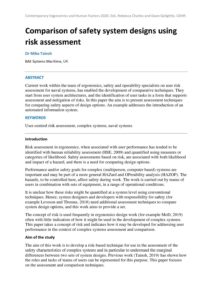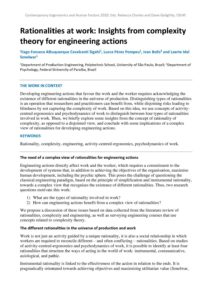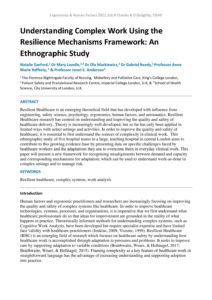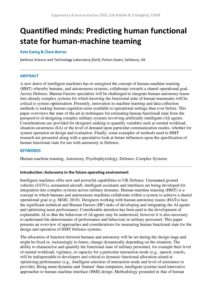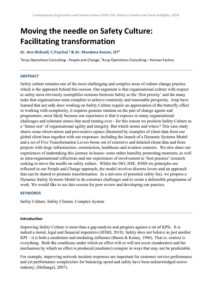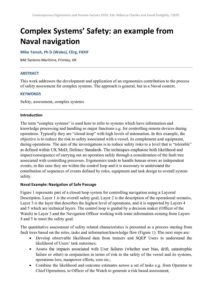Complex systems
Comparison of safety system designs using risk assessment
| Document | Author Dr Mike Tainsh |
| Abstract Current work within the team of ergonomics, safety and operability specialists on user risk assessment for naval systems, has enabled the development of comparative techniques. They start from user system architectures, and the identification of user tasks in a form that supports assessment and mitigation of risks. In this paper the aim is to present assessment techniques for comparing safety aspects of design options. An example addresses the introduction of an automated information system. |
Rationalities at work: Insights from complexity theory for engineering actions
| Document | Author Tiago Fonseca Albuquerque Cavalcanti Sigahi, Lucca Pérez Pompeu, Ivan Bolis and Laerte Idal Sznelwar |
| Abstract Developing engineering actions that favour the work and the worker requires acknowledging the existence of different rationalities in the universe of production. Distinguishing types of rationalities is an operation that researchers and practitioners can benefit from, while disjoining risks leading to blindness by not capturing the complexity of work. Based on this idea, we use concepts of activity-centred ergonomics and psychodynamics of work to distinguish between four types of rationalities involved in work. Then, we briefly explore some insights from the concept of rationality of complexity, as opposed to a disjointed view, and conclude with some implications of a complex view of rationalities for developing engineering actions. |
Understanding Complex Work Using the Resilience Mechanisms Framework: An Ethnographic Study
| Document | Author Natalie Sanford, Dr Mary Lavelle, Dr Ola Markiewicz, Dr Gabriel Reedy, Professor Anne Marie Rafferty, & Professor Janet E. Anderson |
| Abstract Resilient Healthcare is an emerging theoretical field that has developed with influence from engineering, safety science, psychology, ergonomics, human factors, and aeronautics. Resilient Healthcare research has centred on understanding and improving the quality and safety of healthcare delivery. Theory is increasingly well-developed, but so far has only been applied in limited ways with select settings and activities. In order to improve the quality and safety of healthcare, it is essential to first understand the sources of complexity in clinical work. This ethnographic study of five hospital teams in a large, teaching hospital in central London aims to contribute to this growing evidence base by presenting data on specific challenges faced by healthcare workers and the adaptations they use to overcome them in everyday clinical work. This paper will present a new framework for recognising misalignments between demand and capacity and corresponding mechanisms for adaptation, which can be used to understand work-as-done in complex settings and to manage risk. |
Quantified minds: Predicting human functional state for human-machine teaming
| Document | Author Kate Ewing & Clare Borras |
| Abstract A new dawn of intelligent machines has re-energised the concept of human-machine teaming (HMT) whereby humans, and autonomous systems, collaborate towards a shared operational goal. Across Defence, Human Factors specialists will be challenged to integrate human-autonomy teams into already complex systems for which knowing the functional state of human teammates will be critical to system optimisation. Presently, innovation in machine learning and data collection methods is making human cognition more available to operational settings than ever before. This paper overviews the state of the art in techniques for estimating human functional state from the perspective of designing complex military systems involving artificially intelligent (AI) agents. Considerations are provided for designers seeking to quantify variables such as mental workload, situation awareness (SA) or the level of demand upon particular communication modes, whether for system operation or design and evaluation. Finally, some examples of methods used in HMT research are presented along with a speculative look at future influences upon the specification of human functional state for use with autonomy in Defence. |
Moving the needle on Safety Culture: Facilitating transformation
| Document | Author Dr. Ann Bicknell, C.Psychol. & Dr. Mandana Kazem, IET |
| Abstract Safety culture remains one of the most challenging and complex areas of culture change practice which is the approach behind this session. Our argument is that organisational culture with respect to safety most obviously exemplifies tensions between Safety as the ‘first priority’ and the many tasks that organisations must complete to achieve continuity and reasonable prosperity. Arup have learned that not only does working on Safety Culture require an appreciation of the butterfly effect in working with complexity, it requires genuine stamina on the part of change agents and programmes, most likely because our experience is that it exposes so many organisational challenges and reluctant stones that need turning over - for this reason we position Safety Culture as a ‘litmus test’ of organisational agility and integrity. But which stones and where? This case study shares some observations and provocative opines illustrated by examples of client data from our global client base together with our responses: including the launch of a Dynamic Systems Model and a set of Five Transformation Levers borne out of extensive and detailed client data and from projects with large infrastructure, construction, healthcare and aviation contexts. We also share our experiences of undertaking this journey in-house: some rather humility promoting moments, as well as intra-organisational reflections and our experiences of involvement in ‘best practice’ research seeking to move the needle on safety culture. Whilst the ISO, HSE, IOSH etc principles are reflected in our People and Change approach, the model involves discrete levers and an approach that can be shared to promote transformation. In a universe of potential safety foci, we propose a Dynamic Safety Systems Model to de-construct challenges and to create a defensible programme of work. We would like to use this session for peer review and developing our practice. |
Complex Systems’ Safety: an example from Naval navigation
| Document | Author Mike Tainsh |
| Abstract This work addresses the development and application of an ergonomics contribution to the process of safety assessment for complex systems. The approach is general, but in a Naval context. |

